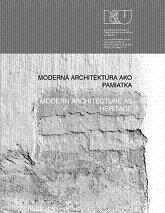MODERNISM BECOMING HERITAGE
MODERNISM BECOMING HERITAGE
Author(s): Andrej HrauskySubject(s): Cultural Essay, Political Essay, Societal Essay
Published by: Historický ústav SAV, v. v. i.
Keywords: functionalism; architecture; Slovenia; conservation; preservation; icon; symbol; 20th century; Ljubljana
Summary/Abstract: The text has two parts. In the first one the author wants to deal with the problem of functionalism in architecture in general. How it came to being and what are his roots. Changing a style in Europe, where culture is deeply rooted in civilisation, is a dramatic revolutionary process, where all values are questioned. In the so called “New World” these roots are not so strong and the changes are therefore much easier. Architects believe that each change in new technologies require the reaction with a new style. This brings style closer to fashion. A new style is only a symbolic representation of a new society. In this respect the name Functionalism only describes that the new symbols are derived from the world of machines – bit this does not mean that the buildings are more functional as those in the past. On the contrary – the buildings of that period between the world wars are designed precisely for their function and therefore not flexible enough to follow the development of technology and living standards. They can be hardly converted for new uses and sometimes can not fulfil contemporary needs for their original purpose. In the second part we get more information of a particular situation in Slovenia, where Functionalism between the wars was shadowed by the strong personality of Jože Plečnik and his classicism. For political reasons functionalism could continue his development with the new post-war generation, when under the leadership of professor Ravnikar reached its peak in the so called Ljubljana School of architecture. Ravnikar succeeded to continue the tradition of Jože Plečnik in a conceptual approach to architecture without copying its architectural language. On the other hand he tried to adapt the International architectural style of the day to local tradition, a process that we know from Alvar Aalto or Luis Barragan. If in the pre-war time architects made, with few exceptions, more or less successful implantation of the foreign models, Ljubljana School of Architecture is different. It is not a delayed echo of global development, but a contemporary creative contribution to the mosaic of the world architecture. And exactly this architecture is threatened. With each new regime the monuments and street names are usually changed, sometimes this change affects also architectural monuments that represent the old political system. Functionalist buildings were too few to be the target of socialism after the war. Contrary to expectations it was the recent turn towards capitalism that threatens the post-war architecture. We lost several important buildings of this period where the modern investors declared them as symbols of socialist regime only to be able to tear them down. These are acts of primitivism as no nation can afford to lose its cultural highlights especially if we consider the bad quality of speculative architecture that replaced them. There are three examples of high quality buildings of Ljubljana
Journal: Architektúra & Urbanizmus
- Issue Year: 44/2010
- Issue No: 3-4
- Page Range: 228-241
- Page Count: 14
- Language: English

